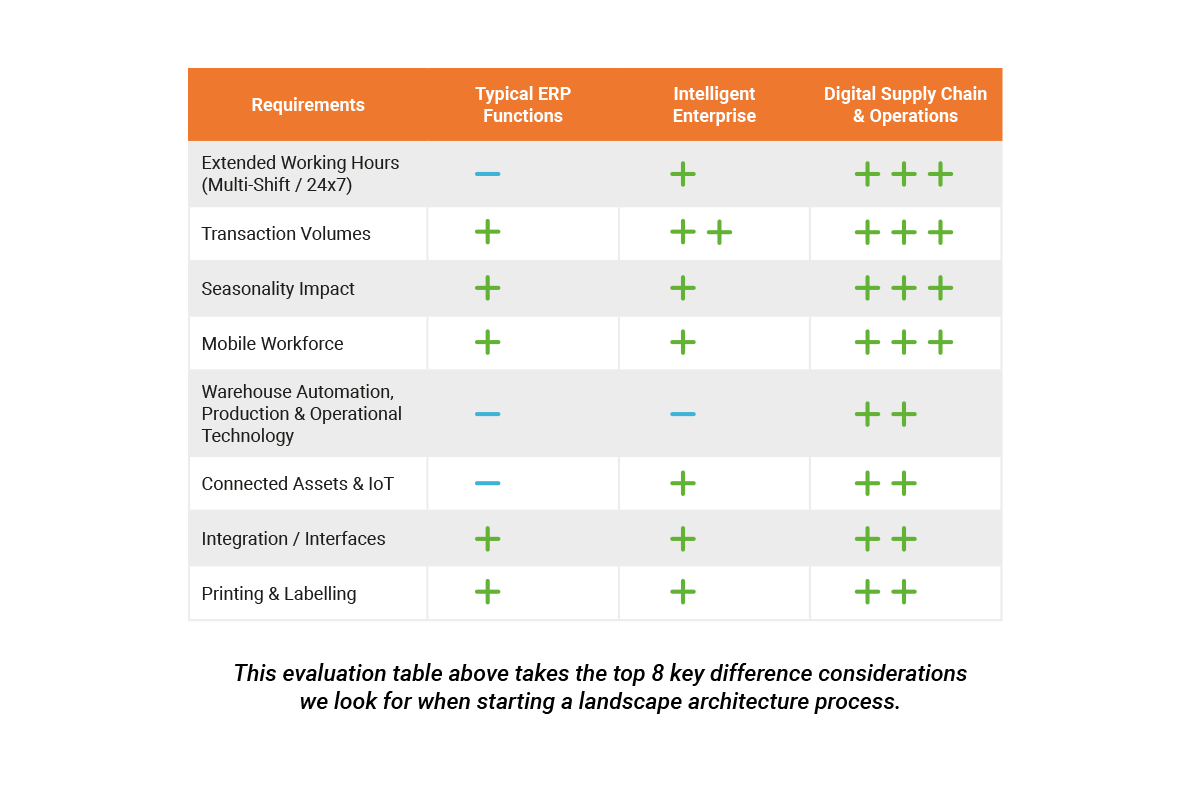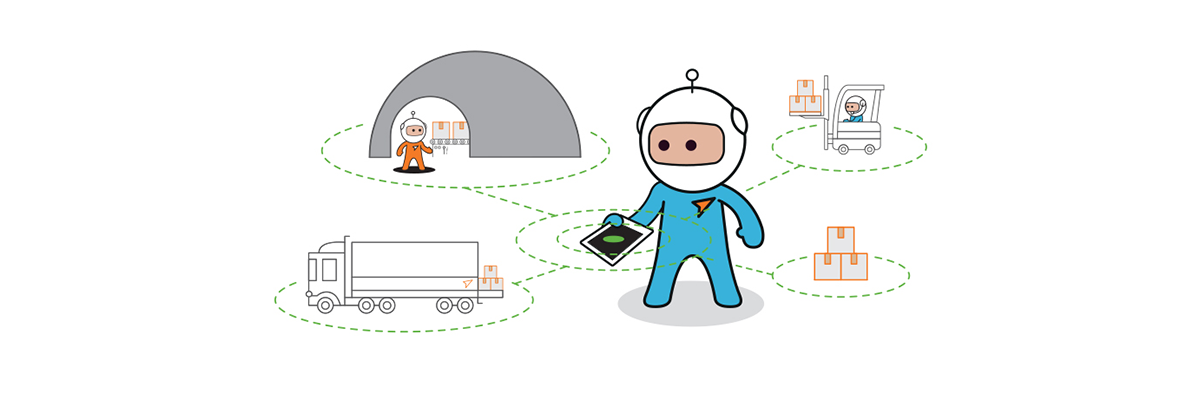Take a deeper dive into the top 8 key supply chain scenario considerations we look for when starting a landscape architecture process.
Getting Your Landscape Right
The importance of correctly architecting, implementing, and maintaining the SAP landscape has never been more important. With the ever-increasing capability and reach of enterprise software, greater reliance on real-time processes and data, and ever more innovative application of technology as business digitalisation marches forward, the demands placed on businesses SAP landscapes are ever-growing.
Coupled with the many different deployment options to consider across on- premise, Cloud and hybrid, as well as the alternatives for embedded supply chain capabilities within SAP S/4HANA, suitable for some situations versus dedicated decentralised options for higher demanding business scenarios, the role and scope of the traditional SAP BASIS architect and approach to landscape design has been surpassed.
If you are extending the reach of your existing SAP landscape with the addition of digital supply chain platforms, adopting SAP S/4HANA, or simply looking to modernise and prepare for the future, then be sure to modernise your team to keep pace with this shift towards the intelligent enterprise.
Page Contents
Key Considerations for Your Landscape Needs
Warehouse Automation, Production & Operational Technology
Implementation & Ongoing Maintenance Recommendations

Introduction
Reliable system access and performance is generally the expected norm these days; however, the interpretation really does depend on the environment and business function.
What is acceptable for a 9 to 5, Monday to Friday, desk-based, back- office workforce will be very different to a multi-shift production facility or supply chain hub with mobile workers and connected operational technology.
For the supply chain and operations aspect of many businesses, the impact of downtime (scheduled or otherwise) can have huge implications to production of shipping volumes. As can dips in system performance that, if not maintained at optimal levels, quickly diminish the performance of a highly connected real-time workforce, production equipment or warehouse automation.
In this guide, we provide you with some key considerations for your landscape needs and tips from our unique Rocket design & operational thinking approach that we use in the design and implementation of SAP for supply chain and operational scenarios, plus implementation & ongoing maintenance recommendations and to ensure the SAP solution is underpinned with a high-performance, high resilience landscape, fit for purpose to maintain business output.
If your business is an asset and supply-chain intensive, and you rely on supply chain agility and responsiveness to remain ahead of the curve.

Key Considerations for Your Landscape Needs
When considering your business needs it can be useful to first understand why the supply chain and operational functions, or indeed those of a connected, intelligent digital enterprise solution such as SAP S/4, place different demands to a typical back-office ERP.
This evaluation table above takes the top 8 key difference considerations we look for when starting a landscape architecture process.
It’s our goal to help you understand how to address these challenges and provide your enterprise with the necessary performance and business continuity to supply chain, production, and digital operations.
Being able to account for the specific operational needs with respect to these considerations within the landscape design, downtime can be mitigated using decentralised systems, for example decentralised SAP Extended Warehouse Management (SAP EWM) or SAP Transportation Management (SAP TM). Decentralised SAP systems work seamlessly with SAP Business Suite (SAP ECC) and SAP S/4, taking advantage of out-of-the-box integration but with the added advantage that the systems can be designed, scaled and operated independently of the ERP system to meet the unique requirements of the digital supply chain and operations environments.
Let’s take a look at the impact of some of these requirements on the SAP landscape architecture design...

Extended Working Hours
Supporting multi-shift environments, especially 24x7 operations, presents a significant challenge for landscape design and maintenance. Planned system downtime must be minimised as even an hour can present a significant loss of production capacity or logistics throughout.
Building a resilient SAP landscape is all about operational stability and business continuity, necessary across the entire business but even more so in operational and supply chain environments where mission-critical quickly meets real-world implications, should failure occur.
Rocket Tip:
Designing for availability ensures SAP application uptime even in the event of localised software or hardware failures.
In production environments, it is important to guard against a single point of failure for each application and infrastructure component. This can be achieved by the principles of isolation and redundancy.
• Isolation - Ensure that all components involved are isolated on an application and infrastructure layer.
• Redundancy - Ensure that all components involved are redundantly available on an application and infrastructure layer.
Keeping these basic principles in mind, the best practice is to implement 3-tier systems across the SAP landscapes, ensuring that all application components involved are isolated from one other and can achieve high availability through redundancy.
Applying resiliency to the SAP application servers, using fewer, smaller servers instead of one larger application server. The practice is to configure the guest operating system's cluster technologies, such as Windows Failover Cluster or Linux Clustering software, to help ensure short failover times of the SAP Central Services and database management system (DBMS). To ensure there is no (or minimal) data loss, the best practice is to configure DBMS synchronous or asynchronous replication, depending on the scenario.

Transactional Volumes
A one-size-fits-all approach to systems in the SAP landscape can work well for simple businesses but is less effective for supply chain and operationally intense organisations where the demands on the ERP and the digital supply chain systems can vary significantly.
Due to the granular nature of the processes executed within a digital supply chain system, the transaction volume can easily be a factor of 3 to 8 times higher; for example, a single sales order with 5-line items in an ERP system can easily equate to 20-30 individual steps to be executed in a warehouse (pick, transfer, place, label, pack, load) and that’s without considering Value Added Services, automation, and the yard activities.
Rocket Tip:
It is important to undertake a quality sizing exercise for your SAP deployment and to right-size compute storage and network capacity.
SAP provides a useful sizing tool to help with this; however, getting data that correctly reflects how you will work with SAP is critical. Legacy system and process data is a useful guide, but thinking about your current and forecast throughput in the context of your future ways of working will provide more accurate results.
Whether a seasonal business or a growing business, designing how you can scale your landscape is essential to maintain business as usual performance efficiently and meet the demands of varying or additional workload.
Ensuring the workload is intelligently balanced across the available resources is important. Consider the use of SAP redundancy features such as logon groups and batch server groups to assign application servers based on current headroom. Take advantage of SAPs ability to automatically dispatch the workload to multiple application server instances, giving the system the capability to (automatically) scale out or scale in when demand increases or decreases.
Project workload is also an important consideration, for example, where a large data volume is to be processed during a time-sensitive cut-over. Temporarily bulking up your infrastructure to accelerate your SAP migration throughput can be a useful technique in these circumstances, ensuring cut-over can fit within the allowed window.
Businesses that face seasonal peaks in demand have two challenges to deal with from a system point of view; increases in user numbers through contingent labour
to service the seasonal demand and the scalability of the system capacity necessary to support the increased workforce and transactional volumes.
Rocket Tip:
For businesses running physical hardware, the typical approach to sizing is to scale for peaks and short to mid-term forecasts with a plan to increase the compute capacity of the database server or scale horizontally by adding application servers when demand surpasses in the longer term. For some, this remains the simplest approach, particularly with on-premise equipment.
However, where a Cloud or Virtualised infrastructure is used, building in easy to administer or even automated processes for rapidly scaling systems for peaks in demand or annual growth, provides a cost-effective method of scaling for peaks in system load, especially when combined with proactive monitoring.
Furthermore, tools such as Single-Sign-On (SSO) and Active Directory (AD) integration should be considered to ensure quick set-up of users and can reduce the administration time for seasonal staff set-up.

Mobile Workforce
ERP/back-office users are typically PC first users with occasional mobile access, often through smartphones/tablets, whereas mobile-first workers make up a large percentage of the digital supply chain workforce; executing very high volumes of transactions through specialised industrial mobile devices, combining scanning, imaging and data capture through user interfaces such as Rocket Mobile or other mobile technology such as voice devices, optimised for a high-performance digital operations mobile workforce. This mobile workforce depends on consistent sub-second response for efficient real-time operations to underpin the productivity and throughput of these working environments.
Rocket Tip:
Correctly sizing to provide the necessary performance for the given workforce make-up is key foundation, but to maintain performance as system load varies, correctly load balancing across the available application servers is critical to avoid workload bottlenecks. Proactive monitoring of system performance (see below) helps maintain response times for this response sensitive workforce.
Warehouse Automation, Production & Operational Technology
From warehouse automation and automated production to autonomous mobile robots plus everything in between, operational technology plays a huge role in modern supply chains.
Ensuring this type of technology can perform to its best requires a specialised approach to process design, technical integration, and landscape architecture, without which material handling and technical bottlenecks will almost certainly hamper performance.
Rocket Tip:
Early collaboration with the automation providers and your SAP team is essential in establishing the performance and throughput criteria, designing and agreeing on the optimal integration approach and architecture (e.g., IDoc vs telegram vs RFC vs API). Noting that different types of automation will place distinct demands on your SAP landscape, require varying components in the landscape and benefit from unique optimisation of dialogue processing for each scenario and architecture type.

Connected Assets & IoT
As enterprises, supply chains and digital manufacturing adopt smarter technology and assets, the flow of data is increasing, and the type of data is evolving. With this comes different considerations for the system landscape to capture, communicate and interpret this type of data.
Rocket Tip:
Care must be taken to process the raw data associated with connected assets in specialised platforms designed for these types of data protocols and volumes. Determining how and where this type of data is used to drive intelligent processes is an important aspect of the landscape design and sizing. Carefully consider where data is valuable to drive an action or outcome and avoid flooding systems with redundant data and compromising overall performance for little or no benefit.
Integration / Interfaces
Receiving and exchanging information with internal systems and technology as well as external parties within the business landscape is part of the large proportion of system landscape and process. This is even more so when we look at supply chain scenarios where not only does the volume of interfaces tend to increase, but so
does the variability of protocols/interface types and the time sensitivity of some of these data exchanges, particularly when we look at integration between systems.
For example, an SAP S/4 system and an SAP Extended Warehouse Management (SAP EWM) or Transportation Management (SAP TM) system, or indeed subsystems typical to production, warehouse, and yard facilities where system processes and any corresponding interfaces must keep pace with the speed of operation.
Rocket Tip:
Defining an integration and interfacing strategy to set out the integration scenarios will ensure the system architecture is designed correctly to support these:
-
types of data (master data, transactional data, operational status data...)
-
technical protocols
-
architecture and integration components/ hubs in the landscape, such as SAP Gateway, SAP Process Orchestration, SAP Business Technology Platform
-
processing timeframes (batch, synchronous, asynchronous...)
-
processing volumes
-
processing target time windows • exception and reprocessing
Different scenarios will present different performance loads to the system, which should be optimised to efficiently use system resources within the context of the available capacity and priority.
Printing & Labelling
While back-office functions regularly rely on printing of outputs, these are typically less time sensitive and lower volume than the printing requirements of a production line or warehouses where label and document printing is an intrinsic part of material handling process steps; in-line printing within warehouse automation or production lines is especially time critical.
Rocket Tip:
Printing set-up is a key aspect of the landscape architectural design, so be sure not to overlook this. Establishing at the start of the project will have an influence on sizing element of the infrastructure required.
Categorising the required printing scenarios, types (e.g. document, label, in-line printing, mobile printing), the appropriate communication protocols (e.g. direct IP, printer server, mobile) and the minimum response times for each printing scenario is essential.
Furthermore, anticipating printer outage exception scenarios and how to allow end-users to manage this easily is a practical step to avoiding potential resulting delays.

Implementation & Ongoing Maintenance Recommendations
It’s one thing designing a high- performance SAP landscape, but making sure it achieves the necessary performance and stays that way is equally important.
Testing
Testing forms an essential part of every project, ensuring the processes meet the business requirements, are usable and practical in the real-world environment that people will work, and that any technology works seamlessly and reliably.
Rocket Tip:
- Performance & Volume Testing – can the system support the designed throughput without bottlenecks in system resources and corresponding reduction in business performance (e.g., loss of productivity through slow mobile performance, warehouse automation backlogs due to interface/messaging queues, production line backlogs due to slow receipt and backflush processing...). Automated testing can be useful when trying to simulate a full operation workload for stress testing of the system against planned steady state and peak loads to ensure the forecast volume of work be managed within the prescribed time.
- Day-In-the-Life-Operation – Can the full combination of activities be performed in a real- life situation and sustain the expected volumes with the expected workforce.
- High Availability – Test these aspects to the landscape with simulated failures, assess the interruption time and impact on performance is within acceptable parameters.
- Backup & Disaster Recovery – Proving the Backup & Disaster Recovery design before you need it is a sensible precaution, especially in highly connected digital operations and supply chain environments where integration between systems can add significant complexity to disaster recovery data synchronisation steps. A good Disaster Recovery strategy and process will cover the entire operations landscape, clearly defining the impacts on each interface and checks and actions for recovery.
Plan an In-project Upgrade
It is beneficial to be up to date on system release levels at go-live. With long project timelines, it’s possible to easily be one or two releases behind your desired state at go-live, meaning a system upgrade with the corresponding outage could be necessary within the first year of operation.
Rocket Tip:
To avoid this, include an upgrade phase within the project plan to bring the system landscape up to desired release level and not 18 months old. If planned well, an in-project upgrade can be very efficient as the project team is already assembled and existing testing phases and content can be used, avoiding the costs and disruption of a dedicated upgrade and regression testing project after go-live.

Security
Careful considerations should be in place for this area, especially with contract, outsource and contingent labour being prevalent in the supply chain and a wide variety of system access locations and types, from workstations, mobile devices, line-side and industrial devices as well as off-site portals for business partner access and updates to mention a few, it’s easy to lose track of where and how users are connecting to the systems.
Rocket Tip:
Making sure the systems are always fully protected, even within the development system. Security policies should be adopted at the start of the project, start off well, and the project will not fall foul of any security breach later on.

Archiving
Large data volumes are a common challenge in digital supply chain and digital operations landscapes where granular process execution, interfaces and operational technology can quickly multiply transactional data. Even the very best design of landscapes will eventually clog up and slow down if archiving is not considered and implemented.
Rocket Tip:
Including your data archiving strategy in your SAP landscape design will help ensure you have right-size landscape components, maintain performance and don’t waste unnecessary data storage costs. Archiving topics often go hand-in-hand with reporting and analytics strategy, so this is also beneficial to review as part of landscape design.
Pro-Active Monitoring Landscape Performance
The ability to respond quickly to changes in landscape performance can mean the difference between meeting a day’s production output or hitting the On-time-In-Full customer fulfilment targets on a given day.
Rocket Tip:
Defining the system landscape Key Performance Indicators as part of the Business-as-Usual management allows specific system parameters to be automatically monitored with tools like SAP Solution Manager or SAP Focus Run. A proactive approach provides greater opportunity to react to trends or unexpected performance bottlenecks quickly, protecting service levels, productivity, and user experience.
Proactive monitoring is essential for digital supply chain environments with mobile workforces, warehouse automation and production environments. Mapping and monitoring business-critical processes in Solution Manager ensures the business is aware of any unforeseen process failures.
High-performance Supply Chains With SAP S/4HANA and SAP DSC
Our methodology is helping many leading businesses optimise and harmonise their strategic operational processes with SAP S/4HANA and the SAP Digital Supply Chain suite of platforms. We know defining the right approach and architecture of any SAP S/4HANA transformation journey is a critical foundation to ensure project success.
If your business is asset and supply-chain intensive, and you rely on supply chain agility and responsiveness to remain ahead of the curve, speak to Rocket today to learn why your move towards becoming an 'Intelligent Enterprise' will require a different approach compared to a typical ERP project.






.png?width=200&name=Microsoft_partner_white%20(1).png)